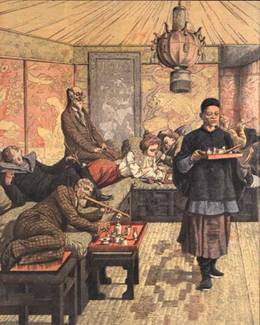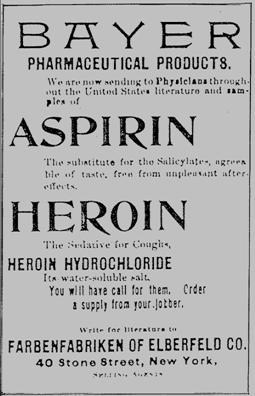Part 2: Opium/Morphine/Heroin
History in Brief : Opium, morphine, and heroin all derive from the same plant and have similar effects that differ in degree. Opium has been used medicinally from the time of Alexander the Great. It was found to be an effective painkiller. Opium's recreational use grew rapidly once people began  to smoke it (which increases the speed and intensity of the effect). Smoking opium became popular in China , and opium dens were common in cities around the world. Opium smoking became such an epidemic in China that the government attempted to ban the practice. However, England made a fortune by producing and selling opium to the Chinese, and thus went to war with China and won the right to sell opium there.
to smoke it (which increases the speed and intensity of the effect). Smoking opium became popular in China , and opium dens were common in cities around the world. Opium smoking became such an epidemic in China that the government attempted to ban the practice. However, England made a fortune by producing and selling opium to the Chinese, and thus went to war with China and won the right to sell opium there.
Opium was a common ingredient in household medicines. It was even used medicinally to stop babies from crying. In the USA , the first national law concerning opium was the 1906 Food and Drug Act, which required the labeling of any product with opium in it. As a result of the labeling of opium products, the use of opium began to decline. Opium smoking in the United States was associated with Chinese immigrants, mostly men in the west who were here to work on the railroads. The opium dens here were run mostly by Chinese men (there were few Chinese women in the U.S. at the time). This led to a concern that opium was being used by Chinese men to seduce white women into "white slavery and prostitution." As a result, the first laws banning any drug in the U.S. were a prohibition in western cities against opium smoking, which was essentially aimed at Chinese men.
Morphine was invented from opium as a potent medicine. It quickly became a standard painkiller used around the world. However, morphine use led to addiction. Despite the known addictive nature of morphine, it was actually prescribed by doctors to alcoholics on the grounds that a morphine addict was better than an alcoholic. Where alcoholics have a propensity to be loud, violent, and aggressive, morphine addicts are quiet, withdrawn, and passive. Like most other drugs morphine became restricted to prescription only in 1914 and became illegal in 1970. However, morphine is still used as one of the most common and effective pain killers in modern medicine.
Like morphine, heroin was invented as a more potent form of opium (far more potent than even morphine). During the American Civil War heroin was thought to be an important medical breakthrough for two reasons. First, heroin (the "hero's drug") was an effective painkiller at a time when thousands of men were having legs and arms amputated by use of a hacksaw. Second, heroin was thought to be an improvement over morphine because it could be injected rather than eaten. At the time it was thought that the cause of morphine addiction was the "taste" of morphine as it went through the digestive tract. Therefore, since heroin was injected directly into the bloodstream it would be less addictive. This mistake led to the first American drug epidemic, which was heroin addiction by Civil War veterans.
 During alcohol prohibition, heroin (and morphine) were widely used by middle class women, as drinking for women was socially unacceptable. Heroin and morphine became the drugs of choice for women (in part due to the discrete nature of using the drug). Heroin was so popular amongst women that it was made available for $2.50 in the Sears & Roebuck catalogue. For your $2.50 you received by mail several doses of the drug along with a syringe and ornamented carrying case. Heroin was also used in household medicines. For instance, as the 1897 advertisement reveals, Bayer aspirin had heroin as a central ingredient. Like opium and morphine, heroin became restricted to medical prescription only in 1914. Then, in 1919 the Supreme Court ruled that doctors could only prescribe it as a treatment and not just to maintain an addiction. As a result of this decision, doctors were the largest group of people arrested for violating drug laws. The violation was "mis-prescribing it" and resulted in an effective ban as doctors were afraid that any prescription for these drugs could lead to a jail sentence if a court found it was not legitimate medicine. This led to a massive increase in crime as addicts could not obtain the drugs cheaply and conveniently from their physician. In 1970, heroin was banned outright. The use of heroin declined from 1970 until the later 1990s when the drug resurged in popularity.
During alcohol prohibition, heroin (and morphine) were widely used by middle class women, as drinking for women was socially unacceptable. Heroin and morphine became the drugs of choice for women (in part due to the discrete nature of using the drug). Heroin was so popular amongst women that it was made available for $2.50 in the Sears & Roebuck catalogue. For your $2.50 you received by mail several doses of the drug along with a syringe and ornamented carrying case. Heroin was also used in household medicines. For instance, as the 1897 advertisement reveals, Bayer aspirin had heroin as a central ingredient. Like opium and morphine, heroin became restricted to medical prescription only in 1914. Then, in 1919 the Supreme Court ruled that doctors could only prescribe it as a treatment and not just to maintain an addiction. As a result of this decision, doctors were the largest group of people arrested for violating drug laws. The violation was "mis-prescribing it" and resulted in an effective ban as doctors were afraid that any prescription for these drugs could lead to a jail sentence if a court found it was not legitimate medicine. This led to a massive increase in crime as addicts could not obtain the drugs cheaply and conveniently from their physician. In 1970, heroin was banned outright. The use of heroin declined from 1970 until the later 1990s when the drug resurged in popularity.
Science in Brief
- Highly addictive (heroin is one of the most addictive of all drugs; morphine is also very addictive).
- Overdose will kill (euthanasia with a morphine drip is very common today).
- Use causes serious weight loss.
Amphetamine (Speed)
History in Brief: Speed is a product of the 20 th century. Initially it was developed as a sinus treatment (Benzedrine) and was referred to as "popping bennies." From here it became used recreationally and also work related as it enabled people to work longer and harder. During the Second World War, Hitler was said to use amphetamines as much as five times a day. It was also given to German troops to increase the effect of the Blitzkrieg. Even today it is used by truck drivers to enable them to drive long hours. The U.S. Air force issues "go" pills (a form of amphetamine) to aid pilots in long military flights. Many of those arrested for using speed have been housewives who use it to help complete housework faster and maintain a high energy level. Athletes have been found to use it to increase performance in football, bicycling, and even horseracing.
Science in Brief
- Speed is highly addictive.
- Speed causes euphoria, confidence, ability to work long hours at even repetitive tasks (resist fatigue).
- Speed overdoses are common (use can "explode" the heart by ripping a hole in it).